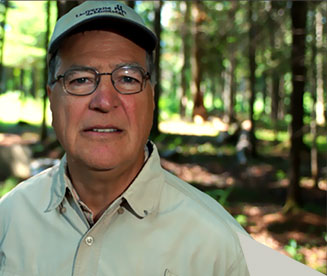Video produced by ArchAnge films for the Musée de la nature et des sciences de Sherbrooke
Informant : Claude Chapdelaine, Professor Emeritus, Université de Montréal
Date : September 2018
Location : Musée de la nature et des sciences de Sherbrooke
Length: 3:52
Archaeologist Claude Chapdelaine presents methods used to analyze, describe and interpret archaeological artifacts.
On-screen text: Scientific approach - analysis.
Claude Chapdelaine is standing in front of archaeological display windows at the MNS2 and speaking to us.
On-screen text: Claude Chapdelaine, archaeologist, Anthropology Department, Université de Montréal
[Claude Chapdelaine] Analysis is a stage in the archaeological process that can be very demanding. It first requires a description of the objects. To do this, the right variables must be selected to properly describe the shape and format, and then hypotheses must be formulated. These hypotheses generally consist of a comparison made with other assemblages. It is often said that while a dig may last one month, the rest of the year will be necessary to analyze, describe, and interpret the document or archaelogical archives that have been updated, using various methods.
On-screen text: Scientific approach - Ethnoarchaeology.
[C.C.] One of the most common methods used in archaeology to describe remains in a more detailed manner is either ethnoarchaeology or ethnohistory. This provides a reference framework enabling comparisons of objects found with either historical data, or data gleaned from experiences with populations with a cultural background comparable to the one being studied and who occupied a comparable environment, in this case the first settlement of the Eastern Townships.
On-screen: Black-and-white photograph of an Inuit family (a woman with a baby in a baby carrier on her back, a young boy, and the father) sitting on a tree trunk. The woman is sewing and the man appears to be carving wood.
[C.C.] One specific case is that of the Inuit who lived and still live in the Arctic, in a very cold environment.
Return to the visual of Claude Chapdelaine.
[C.C.] The Palaeoindians who occupied the Eastern Townships also occupied an area that had just been freed of ice. The glacier was north of the St. Lawrence River, and the climate was very cold. Parallels may be drawn from the lifestyle of the Inuit and that of the Palaeoindians, always keeping in mind that there are differences and that this is not a formula that should automatically be applied. The Inuit, for example, lived on the shores of a sea whereas the Palaeoindians in the Eastern Townships lived inland. It can be assumed that the Inuit hunted caribou and seals. Inland, in the Eastern Townships, caribou were also hunted along with a wider variety of other wildlife, but certainly there were no seals to hunt in the Eastern Townships.
On-screen text: Scientific approach - Experimental Archaelogy.
[C.C.] Interpretation is an evolving approach in archaeology; there are new methods, and technology cannot be ignored. One method is called traceology, which is the study of traces. Archaeologists use a special microscope that can enlarge by 400 times the part of the object that they want to try to understand. Traceology is one of the approaches that can be used with our equipment. On the Kruger 2 site, in Brompton, some 75 borers have been found. On-screen: A succession of three photographs, respectively showing 7, 11, and 6 borers or fragments thereof, i.e. long, pointed chipped stones.
[C.C.] The traceological analysis has not been done, but these 75 borers constitute a very important assemblage, a somewhat extreme number in comparison to other sites of this period where 5 or 10 borers have been found.
Return to the visual of Claude Chapdelaine.
[C.C.] Traceology could enable us to verify whether all of these borers were used for the same task, i.e. to perforate holes in antlers, wood, or horns, or if their long bits mean they were used as a specialized tool for other functions. It is believed that traceology could teach us more and perhaps go beyond the traditional interpretation that a borer is made for boring.



